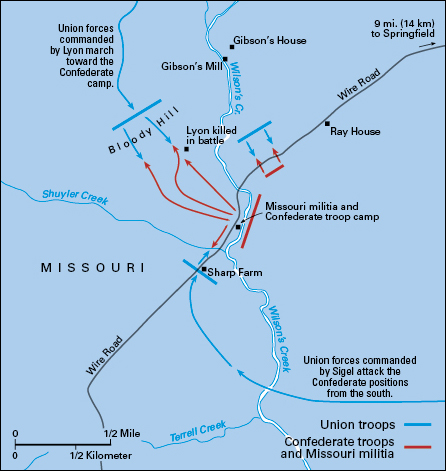
Wilson’s Creek, Battle of , was the first major battle fought west of the Mississippi River during the American Civil War (1861-1865). It took place among the rolling hills of southwestern Missouri on Aug. 10, 1861. Confederate fighters forced an outnumbered Union army to retreat. The battle gave the Confederates control over southwestern Missouri.
Background.
When the Civil War began in April 1861, the people of Missouri debated whether to join the Confederacy or remain in the Union. President Abraham Lincoln called for troops from Missouri to support the Union war effort. However, Missouri governor Claiborne F. Jackson, who supported the Confederacy, refused Lincoln’s call.
Nathaniel Lyon, who was then a captain, took command of Union forces in St. Louis. Governor Jackson had command of Missouri state militia (citizen soldiers) camped just outside of the city. Lyon feared that the militia would try to capture the Union arsenal (weapon supply) in St. Louis. On May 10, his army arrested and disarmed the state troops. When the army marched the prisoners away from the Confederate camp, Lyon and his troops were confronted by an angry pro-Southern crowd throwing stones at them. When a civilian fired a pistol and killed one of Lyon’s officers, Union soldiers fired into the crowd, killing 28 people.
Lyon was promoted to brigadier general on May 12. He soon sought to rid Missouri of pro-Confederacy forces. His troops defeated Jackson’s militia at Boonville, in central Missouri, on June 17. Jackson’s militia then retreated to southwestern Missouri. The militia included the famous guerrilla leader William Quantrill (see Quantrill, William Clarke ). Lyon’s forces, known as the Army of the West, pursued the militia. In July, a Missouri state convention declared the state’s loyalty to the Union and voted pro-Confederate officials from office. Hamilton Gamble replaced Jackson as governor.
The battle.
In early August, Jackson’s militia, together with regular Confederate troops, camped along Wilson’s Creek, about 10 miles (16 kilometers) southwest of Springfield, Missouri. The Confederate force, now led by General Benjamin McCulloch and Missouri militia leader Sterling Price, numbered more than 10,000 men.
On the evening of August 9, Lyon and about 5,400 Union troops marched from Springfield toward the Confederate position. The next morning, Lyon split his army into two groups. He remained with one group, and Brigadier General Franz Sigel led the other. Lyon sent Sigel to attack the Confederates’ position from the rear, but Sigel halted his attack. Lyon’s troops had initial success attacking the Confederates’ front lines, but a Confederate counterattack halted their advance. Union forces then held off two strong attacks at a nearby site known as Oak Hill, renamed Bloody Hill after the battle. Lyon, however, was shot while rallying his men. Lyon became the first Union general to be killed in combat. Major Samuel Sturgis replaced him.
After Union forces fought off a third Confederate advance, Sturgis withdrew his troops from the battlefield. During the course of the battle, about 260 Union troops were killed. About 875 were wounded, and nearly 200 were missing. The Confederates suffered about 280 killed and 950 wounded.
Aftermath.
Following the battle, Union troops retreated to Rolla, Missouri. They left a large area of southwestern Missouri to the Confederates. Union forces would again occupy southwestern Missouri after a victory at the Battle of Pea Ridge, Arkansas, in March 1862. Throughout the war, bands of pro-Union and pro-Confederate guerrillas conducted raids on their opponents’ strongholds in Missouri.
See also Missouri (The American Civil War) ; Pea Ridge, Battle of .
